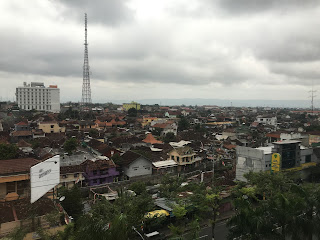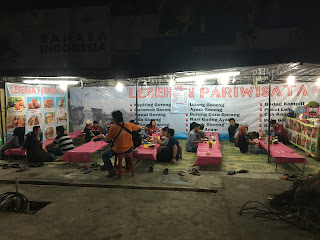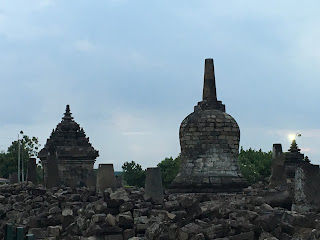We decided to visit the Prambanan Temple area that afternoon and evening. Indonesians claim it is the tallest and most beautiful Hindu temple in the world. It was built around the 9th century and is dedicated to Shiva. The complex originally comprised of 240 temples, but today only the 8 main temples and 8 small shrines are all that have been restored. It reminded us of Angkor Wat in Cambodia, which was built much later in the 12th century. Prambanan is a beautiful temple complex, although much smaller when compared to the expansive temple city of Angkor. You can see the way the tumbled stones are carved to fit together like a puzzle. It will take many years to complete the restoration of this site. The three main temples (Brahma, Shiva, and Vishnu), dominate the landscape. We entered the largest, the temple of Shiva, with it's 4 chambers containing the statues of Shiva (he is deemed the most important God of the universe); Durga (the divine mother of the universe who is armed - pun intended - with many divine weapons and ornaments; Ganesha, (Son of Shiva and most recognized and worshiped God. He has an elephant head and is known as the remover of obstacles.); and Agastya (a Hindu sage commonly referred as the father of medicine.) The carvings on the temples are impressive and tell many Hindu stories of tragedy, romance, courage and misery which are meant to teach ethical values.
One architectural design that I find noteworthy about both Hindu and Buddhist Temples is that both are created to represent three zones or degrees of glory. The temple complex as well as the temples themselves are comprised of three levels: the lowest portion symbolizes the world of humans and animals; the second level represents the realm of holier people, who are beginning to see more light and truth; and the highest zone is the holiest place and is reserved for the Gods. This concept is similar to teachings in the LDS church - and I love that portions of truth exists in different forms among all religions!
Just a short walk from Prambanan are the Buddhist temples of Bubrah, Lumbung, and Sewu (largest) which were built around 792 AD.
A short drive from these temples was a beautiful temple by the name of Plaosan. The story I heard about this temple is that it was built by the Hindu King who was the founder of the Prambanan and Sewa Temples, as a gift for his wife, the daughter of a Buddhist King. This political marriage united kingdoms, and their love is represented in the "twin temple" which features designs from both religions. By the time we arrived, they would not allow entrance, but we could see from outside the gates that this was truly a jewel among the lesser known temples.
There were some small temples in the neighborhood across the street.
Our driver took us to a nearby restaurant to get some dinner at a place that made a nice attempt to lure in tourists, but the linens and pests left us a little wary of eating out! Oh, and I forgot to mention how the prayers of Muslims can be heard echoing throughout Indonesia six times a day. Check it out for yourself . . .
There is a nice outdoor stage set up behind the Prambanan Temple and in the evenings, the temple is lit up as a backdrop for a performance of the Ramayana Ballet. There are four episodes depicting this epic love story of Rama and his wife Shinta - the Romeo and Juliet of Indonesia. This is the same story that is traditionally told through puppets; and the two puppets we purchased at the antique market in Jakarta are representations of Rama and Shinta. Each night, the theater shows just one episode in the saga, and we must have come on a less eventful scene. While the performance itself was very beautiful, Bob and I found ourselves quite bored. Maybe it was just a really long day!
As a summary, below is a collection of brochures and entrance tickets we obtained during our excursion to Candi (Temple) Prambanan.
















































No comments:
Post a Comment